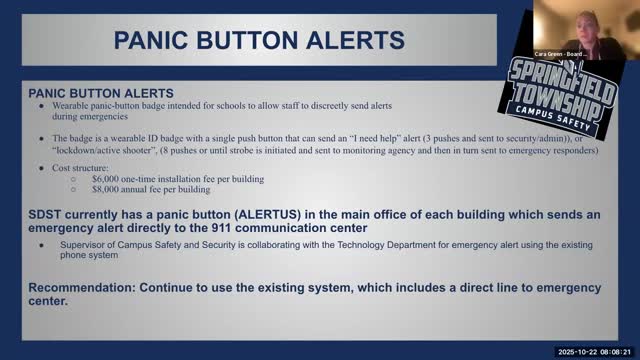Committee weighs wearable panic buttons and AI camera software; recommends keeping Alertus, consider ZeroEyes for 2026–27 budget
October 22, 2025 | Springfield Township SD, School Districts, Pennsylvania
This article was created by AI summarizing key points discussed. AI makes mistakes, so for full details and context, please refer to the video of the full meeting. Please report any errors so we can fix them. Report an error »

Springfield Township School District property committee members reviewed wearable panic‑button options, app‑based panic systems and an AI camera detection product at their Oct. 22 meeting. Staff recommended keeping the district’s existing Alertus connection to Montgomery County dispatch and adding consideration of the AI camera product ZeroEyes to the 2026–27 budget cycle.
District administrators told the committee they researched wearable panic devices — small wearables that can send a discrete alert to a monitoring service — and app‑based panic options such as CrisisGo. The staff presentation listed an example vendor cost for a wearable system at roughly $6,000 installation per building plus an annual fee of about $8,000 per building.
Why it matters: staff said the main operational concern with wearable devices is that they typically send alerts first to a monitoring agency rather than directly to county dispatch, producing a potential time delay and limiting immediate situational awareness for on‑site administrators. Staff reported that Alertus, the district’s installed panic system, connects directly to the Montgomery County Department of Public Safety CAD (computer‑aided dispatch) and dispatches automatically to emergency responders.
Key points made in the meeting:
- Staff recommendation: continue using the existing Alertus system because it provides a direct CAD connection and instant dispatch, avoiding a monitoring‑station middleman.
- App options: the district already uses Ruvna for building‑level emergency messaging and discussed app products (CrisisGo, Raptor/Bridgel Go variants) that can include staff‑initiated panic functions; no procurement decision was made.
- Cost and adoption: staff said they had spoken with other Montgomery County districts; only a few local districts use app‑based panic features.
- AI camera detection (ZeroEyes): staff described a visual firearm detection product that integrates with existing cameras and uses a human verifier to reduce false positives; the product detects a suspected firearm and after human verification typically sends a confirmed alert in about 3–5 seconds.
- Cameras and cost: the district has more than 300 cameras total and about 135 exterior cameras; staff reported a 3‑year contract option for covering exterior cameras and stairwells at just over $44,000 per year, with a lower per‑year cost if committed for five years.
No immediate procurement decision was made. Staff recommended adding the AI camera software to next year’s capital/facilities budget discussion (2026–27) rather than purchasing this year, and continuing to use the Alertus system for direct dispatch.
Ending: Board members asked about false positives, monitoring hours and liability; staff said the AI product relies on human verification to reduce false alerts, the monitoring station operates 24/7, and the district will bring budget details back for review.
District administrators told the committee they researched wearable panic devices — small wearables that can send a discrete alert to a monitoring service — and app‑based panic options such as CrisisGo. The staff presentation listed an example vendor cost for a wearable system at roughly $6,000 installation per building plus an annual fee of about $8,000 per building.
Why it matters: staff said the main operational concern with wearable devices is that they typically send alerts first to a monitoring agency rather than directly to county dispatch, producing a potential time delay and limiting immediate situational awareness for on‑site administrators. Staff reported that Alertus, the district’s installed panic system, connects directly to the Montgomery County Department of Public Safety CAD (computer‑aided dispatch) and dispatches automatically to emergency responders.
Key points made in the meeting:
- Staff recommendation: continue using the existing Alertus system because it provides a direct CAD connection and instant dispatch, avoiding a monitoring‑station middleman.
- App options: the district already uses Ruvna for building‑level emergency messaging and discussed app products (CrisisGo, Raptor/Bridgel Go variants) that can include staff‑initiated panic functions; no procurement decision was made.
- Cost and adoption: staff said they had spoken with other Montgomery County districts; only a few local districts use app‑based panic features.
- AI camera detection (ZeroEyes): staff described a visual firearm detection product that integrates with existing cameras and uses a human verifier to reduce false positives; the product detects a suspected firearm and after human verification typically sends a confirmed alert in about 3–5 seconds.
- Cameras and cost: the district has more than 300 cameras total and about 135 exterior cameras; staff reported a 3‑year contract option for covering exterior cameras and stairwells at just over $44,000 per year, with a lower per‑year cost if committed for five years.
No immediate procurement decision was made. Staff recommended adding the AI camera software to next year’s capital/facilities budget discussion (2026–27) rather than purchasing this year, and continuing to use the Alertus system for direct dispatch.
Ending: Board members asked about false positives, monitoring hours and liability; staff said the AI product relies on human verification to reduce false alerts, the monitoring station operates 24/7, and the district will bring budget details back for review.
View full meeting
This article is based on a recent meeting—watch the full video and explore the complete transcript for deeper insights into the discussion.
View full meeting